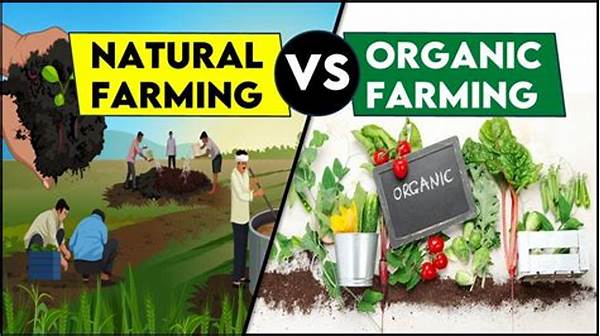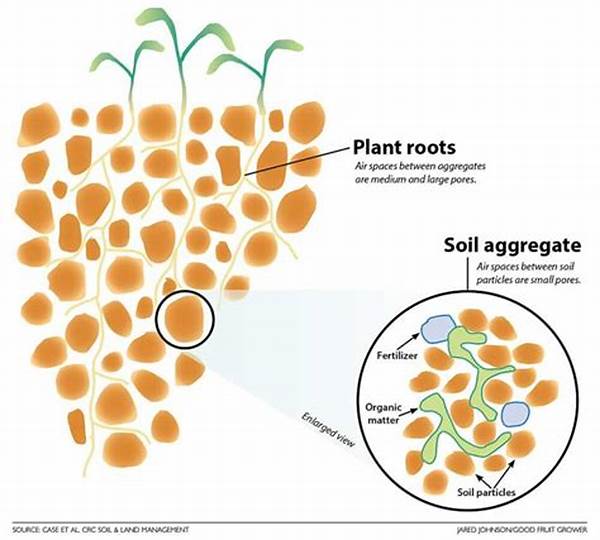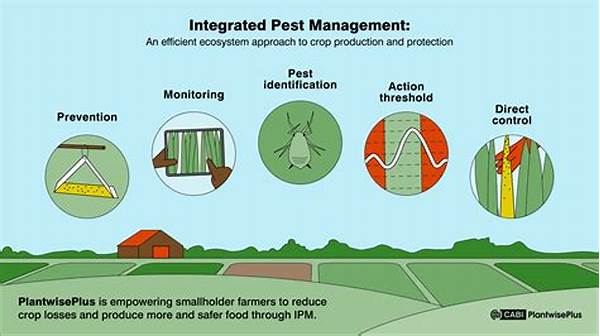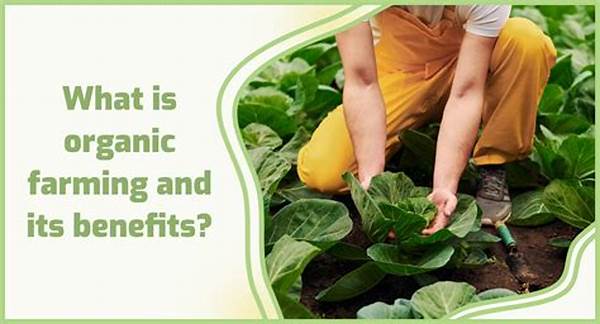In today’s world, where health and sustainability are becoming increasingly important, understanding the differences between natural and organic farming is crucial. While they might seem similar at first glance, these farming practices differ significantly in terms of methods, certifications, and impacts on the environment. As consumers become more conscious of their choices, knowing these differences can guide you in making better decisions for your health and the planet. Let’s explore these distinctions and discover why they matter.
Read Now : Eco-friendly Agriculture Practices Implementation
Understanding Natural and Organic Farming
Natural and organic farming might appear to be the same, but they hold distinct philosophies and practices. Natural farming, often guided by traditional techniques, doesn’t involve synthetic additives or chemicals. It’s about working harmoniously with nature, allowing ecosystems to thrive without interference. Organic farming, while also avoiding synthetic additives, is bound by strict regulations and certifications. These standards ensure minimal impact on the environment and a sustainable approach to agriculture. By delving into the differences between natural and organic farming, you can better appreciate their unique contributions to our food system.
Choosing between natural and organic farming practices goes beyond a mere label. It’s about understanding the approaches and their impacts. Natural farming emphasizes a less-is-more philosophy, utilizing minimal human intervention. In contrast, organic farming incorporates rigorous standards and third-party certifications to ensure practices meet environmental and health criteria. By grasping these differences, you empower yourself to support methods that align with your values and contribute to a healthier planet.
Embracing these practices means more than just making a choice at the grocery store. It’s about joining a movement that prioritizes environmental conservation, health, and sustainability. Whether you opt for natural or organic, understanding the differences between natural and organic farming enables you to become an informed consumer, making choices that reverberate positively across ecosystems and communities.
Key Differences Between Natural and Organic Farming
1. Natural farming shuns synthetic chemicals and aims for ecological balance, while organic farming adheres to strict certification standards and minimum environmental impact.
2. Organic farming requires third-party certification to guarantee compliance with established standards, whereas natural farming might not have such rigorous checks in place.
3. Natural farming is often rooted in traditional practices, prioritizing minimal human intervention, unlike the more regulated organic farming methods.
4. The differences between natural and organic farming also include varying approaches to pest control – natural farming uses companion planting, while organic farming may use approved organic pesticides.
5. Soil fertility management is another area where these practices diverge. Natural farming focuses on natural cycles, while organic farming might employ organic fertilizers and compost.
Benefits of Understanding These Differences
The differences between natural and organic farming are not just academic; they shape how we interact with our environment and food sources. By understanding these distinctions, you can make informed choices that promote sustainability and health. Opting for organic produce means you’re supporting an industry committed to minimizing harmful environmental impacts. This choice aligns with global efforts to reduce pesticide use and promote biodiversity.
Conversely, choosing products from natural farming operations often means endorsing a more locally oriented approach, potentially reducing the carbon footprint associated with food transport. Understanding and valuing these differences allows you to align your consumption habits with broader ecological goals. Whether it’s by supporting organic certification or advocating for traditional farming methods, you are part of a larger movement towards a healthier planet.
By differentiating between these practices, you gain the power to support the agricultural systems that resonate with your principles, enhancing both personal and planetary well-being. This insight underscores the importance of recognizing the differences between natural and organic farming and ensuring our choices reflect a commitment to sustainability and health for future generations.
Practices and Standards in Natural and Organic Farming
Understanding the practices and standards behind natural and organic farming requires a closer look at their fundamental philosophies. Natural farming is often characterized by its minimalistic approach: little to no manufactured inputs, allowing nature to dictate the agricultural flow. It’s an approach that fosters crop diversity, resilience against pests, and soil fertility through natural means. While this practice provides benefits, it’s important to acknowledge its lack of formal certification can sometimes make consumer trust a challenge.
On the other hand, organic farming operates under a comprehensive regulatory framework designed to ensure transparency and consistency. Certification processes are stringent and cover various aspects such as soil quality, animal welfare, and pest control. By investing in organic certification, farmers offer consumers the confidence that products meet established environmental and health standards. The formal structures within organic farming help facilitate wider market access, making it easier for consumers to trust their choices.
Read Now : Community-led Food System Initiatives
Both approaches advocate for healthier soil and reduced reliance on synthetic fertilizers and pesticides, yet they diverge significantly in execution. By understanding the differences between natural and organic farming, you can navigate the farm-to-table journey with a clearer perspective, supporting methods that best align with your beliefs and lifestyle goals.
The Role of Certification and Regulation
The role of certification and regulation is pivotal in distinguishing between natural and organic farming. Organic farming’s stringent certification standards ensure adherence to practices that prioritize environmental health and sustainability. This robust framework provides assurance to consumers about the integrity and quality of their purchases, facilitating trust in the market.
Conversely, natural farming lacks such regulatory oversight, relying heavily on traditional methods and personal reputation. The differences between natural and organic farming in this context can impact consumer confidence. While natural farming focuses on ecosystem harmony, its absence of certification standards may make it challenging for consumers to verify claims independently.
Yet, this lack of formal structure doesn’t detract from the potential benefits of natural farming. It offers an opportunity for farmers to nurture their land according to age-old techniques that work with, rather than against, nature. By understanding these dynamics, you can make confident choices, embracing farming methods that align with your ethical and environmental priorities.
Despite these differences, both natural and organic practices converge on the critical need for sustainable agriculture. By recognizing the nuances in their methodologies, you contribute to a more informed and conscious consumption that supports healthier communities and ecosystems worldwide.
Taking Action: Your Decision Matters
Your choices matter significantly when considering the differences between natural and organic farming. By opting for organic, you endorse a methodical approach to environmental stewardship. This choice supports farmers who are committed to reducing their ecological footprint through certified practices. It signifies a conscious effort to encourage sustainable agriculture, reflecting a commitment to health, ethics, and environmental preservation.
Alternatively, supporting natural farming means embracing a more traditional, community-centered approach. While it may lack certification, the emphasis on minimal intervention and biodiversity plays a key role in promoting sustainable systems. Both methods, though different, contribute to the broader objective of fostering a sustainable agricultural landscape. Recognizing these differences empowers you to make informed decisions that align with your values, advocating for quality farming practices.
Your decision to support one or both of these systems aids in shaping a future where sustainable farming thrives. It’s about choosing not just what you eat, but how it was grown, ensuring that your consumption positively impacts the world. Your choices can become a catalyst for change, supporting a future where the environment, producers, and consumers flourish together.
Conclusion: Harmonizing Practices for a Sustainable Future
In conclusion, understanding the differences between natural and organic farming is essential in navigating today’s agricultural landscape. These differences provide insights into how your food is grown and the stories behind the labels that mark your grocery choices. They reveal the complex dynamics that exist between traditional wisdom and modern regulatory practices, both of which play crucial roles in shaping sustainable agriculture.
The decision to support natural or organic farming—or a harmonious combination of both—contributes to a broader movement towards sustainability, health, and community well-being. By aligning your values with your purchasing power, you encourage practices that not only benefit the planet but also improve the quality of life for future generations. Your informed choices can facilitate a more balanced and sustainable food system, ensuring that agricultural practices continue to evolve in response to environmental and societal needs.
Ultimately, harmonizing the strengths of both natural and organic farming can lead to a resilient agricultural future, one that leverages traditional knowledge and innovative certification to protect the environment while providing for global nutritional needs. Your role as a consumer is pivotal in shaping this future, championing a sustainable legacy that benefits everyone.



